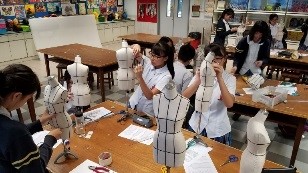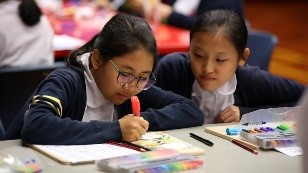Learning Strategy
The design of the Visual Arts curriculum provides students with opportunities to integrate three groups of generic skills – basic skills, thinking skills, and personal and social skills, so that they can complete their tasks and attain a whole-person development.
Basic Skills
- Communication Skills
Talk about works of art by using arts-related vocabulary; present views about the arts orally and in writing; create and perform works of the arts by using visual and/or body language.
- Mathematical Skills
Apply the concepts of shape, size and position in formal analysis of art appreciation; create 3-dimensional illusion on a 2-dimensional plane for art making by using linear perspective.
- Information Technology Skills
Use appropriate Information Technology (IT) tools for art making; search and select information for appreciation, and develop ideas for creating art; use an e-platform to engage students in arts critique and peer assessment.
Thinking Skills
- Critical Thinking Skills
Draw logical conclusions based on evidence (e.g. visual elements, content and art history) when appraising artworks; formulate own arguments based on facts and different views for appraising works of the arts.
- Creativity
Create imaginative artworks with playful themes; discover hidden details in works of the arts and generate an original and convincing interpretation; incorporate new techniques to enhance the presentation of a piece of artwork.
- Problem Solving Skills
Identify a design problem and explore feasible ways to solve the problem with aesthetic quality; identify technical problems and find ways to improve the performing skills; experiment with different materials and techniques for achieving a particular visual effect.
Personal and Social Skills
- Self-management Skills
Use resources economically (e.g. financial expenses and materials) for making a piece of artwork; allocate time to different tasks for completing a visual arts portfolio on schedule.
- Self-learning Skills
Categorize visual artworks according to their genres and styles; develop images and experiment media for establishing a visual arts portfolio with a self-developed theme.
- Collaboration Skills
Liaise with peers to compromise a view for creating a mural; participate in various roles in organizing an art exhibition and staging a theatrical performance.
Coursework
|
Junior levels
|
Artistic creation: With various artistic creation media (drawing, painting, sculpture, pottery, graphic design, printmaking, calligraphy, fashion design, handicraft and digital creation, etc.), guide students to master the skills of using various tools and materials to demonstrate appropriate knowledge and skills in various aspects of art form, media, design, theme and style.
Art diary: Let students record their creative experience, explore and record ideas for future use in artistic creation.
Worksheets: Record class exercises and art appreciation or appraisal.
|
|
Senior levels
|
Artistic creation: With various art creation media (drawing, painting, sculpture, pottery, graphic design, printmaking, calligraphy, fashion design, handicrafts and digital arts, etc.), instruct students to create their own artworks so that they can master the skills of using various tools and materials, thereby demonstrate appropriate knowledge and skills in various aspects of art form, media, design, subject matter and style.
Art diary: Let students record their creative experience, explore and record ideas for future use in artistic creation.
Worksheets: Record class exercises and art appreciation or appraisal.
Portfolio: Let students study and discuss selected topics in depth. Teachers guide students to create in the form of topics. Students have to be able to tell how they understand topics, how to acquire knowledge, how to organize and analyze data, and display learning results.
|


